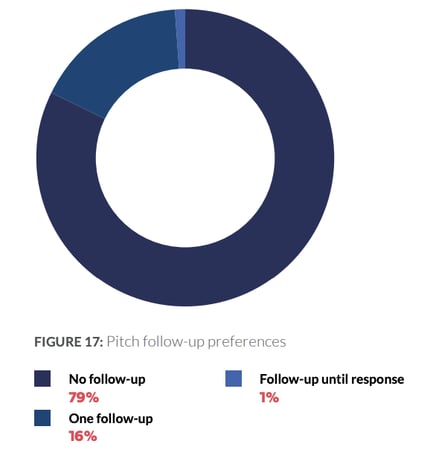Avoid these 5 mistakes to maintain a healthy PR relationship with journalists
%20(2).png?width=1920&height=230&name=5%20common%20mistakes%20blog%20post%20cover%20photo%20(1920%20%C3%97%20230%20px)%20(2).png)
The quest for attention, the hope for pick-up, and the anxious wait for a reply - it all sounds familiar, doesn't it?
But just like with any other relationship, your connection with journalists can go on a downward spiral if you fail to meet their expectations.
In this article, we'll unveil the top five relationship killers as revealed by journalists, and provide you with tips on how to dodge these detrimental mistakes.
#1 Neglecting important details
As they say, “the devil's in the details”. Neglecting key details such as spelling, grammar, the recipient’s name or their subject of interest, can prove fatal for your PR/journalist relationships. Unfortunately, even when small, these mishaps can undermine your credibility and professionalism.
Fortunately, you can avoid this by meticulously reviewing your media contact lists and ensuring they are relevant to your story, as well as double-checking every email before sending it out. At Medianet, we often say “the one who writes it cannot proof-read it” because once you have gone over the same document a few times, it’s hard to see the details. Get someone with fresh eyes to help you pick-up those little things you may have missed.
#2 Sending irrelevant, outdated or stories that are not newsworthy
It might seem obvious, but journalists are only interested in newsworthy content. What is newsworthy and what isn’t? It can be hard for PRs or marketers to objectively discern between what is newsworthy to them and what is newsworthy to the media. We’ve seen countless press releases that are overly promotional and have no news value at all. Sure, it might be an exciting story to the organisation behind that release, but that doesn’t mean it’s meaningful to the journalists’ audience.
So, how do you objectively determine if your story has news value?
Ask yourself how it will impact the audience of the media you are pitching to. Ask yourself if you were reading that publication, would you want to read your story?
Another way to anticipate journalists’ interest in your story is to see if your story fits into any of the journalistic news values: timeliness, proximity, prominence, impact, relevance, oddity and conflict. How to pitch stories into an industry increasingly under pressure
#3 Neglecting personalisation
Sending a generic email to a journalist is a sure-fire way to blend into the crowd and reduce your chances of standing out. No one wants to feel like they're receiving a mass email, and it's a quick way to lose the attention of a journalist. As PR professionals, it's crucial to do everything you can to personalise and tailor your pitch to the right journalists.
Even though some stories are of enough wide appeal for a broad targeting strategy, most stories require some refinement in their targeting and personalisation. Whether it’s alluding to a previous story written by the journalist, or writing a short message within your email, personalisation can go a long way in getting the journalist’s attention. Try answer the question like “why does this matter to me and my audience?”, “what is the news angle?” and “why are you pitching this to me?”
We know from our 2023 Medianet Landscape Report, upon receiving a press release, only 11% of journalists said they read the whole thing before deciding if the story is worth pursuing. The majority of respondents (70%) read less than a paragraph.
Do everything you can to personalise and tailor your pitch to the right journalists. We also know from our 2022 Media Landscape Report that journalists’ top pet peeve is receiving irrelevant information.
"Building relationships with journalists is incredibly important. Before pitching a story to a specific journalist I make sure to read their latest stories so I know they have an interest in what I am sending to them. Sending journalists irrelevant pitches will only sour a relationship and make you lose out in the long run." Anonymous quote, Medianet Australian Media Landscape Report 2023
So what's the solution?
Instead of sending a mass email, take the time to research the journalists and publications that would be the best fit for your story. Look for journalists who might be interested in your story and create a pitch tailored to their interests. That way, you'll be able to send a personalised pitch that's more likely to grab the journalist's attention.
#4 Ghosting
In any relationship, being cordial and polite is crucial, and it's no different in the relationship between PR professionals and journalists. Simple acts of courtesy like saying "thank you" can go a long way and show that you're invested in the relationship. "Ghosting" a journalist by not responding to their messages or not being available for comment on your story can harm the relationship and even your reputation.
Positive interactions can be the start of a great relationship with the journalist and lead to more opportunities for media coverage.. By responding promptly and professionally, you increase the chances of being contacted for expert comments or future stories.
#5 Pushy behaviour
We understand the excitement that comes with having the perfect story pitch for a journalist, but it's important to avoid being annoying by pushing too hard or making inconvenient requests, like demanding phone calls.
As discussed in our recent webinar, calling a journalist to follow up can do more harm than good. Remember that journalists are busy professionals just like you, so it's essential to show your excitement in a way that respects their time and needs. Focus on building strong relationships through various channels, including social media, events, and providing journalists with exactly what they need in the best format for them.

Journalists' pitching follow-up preferences
Source: Media Landscape Report 2022
Conclusion
In order to see success in PR, your relationship with journalists can make or break your chances of media coverage. To ensure success, it's crucial to avoid common mistakes that can quickly sour a relationship. From overlooking small details to being pushy, ghosting, or failing to personalise your approach, there are many pitfalls to avoid.
However, by taking the time to carefully curate your media contact list, researching journalists and publications, and crafting personalised pitches that showcase your understanding of their needs and preferences, you can cultivate a strong approach that transcends your role in the world of media and PR.
Showing appreciation and gratitude for a journalists’ hard work can go a long way in cultivating a relationship built on trust and mutual respect.
So, are you putting in the effort needed to foster strong PR relationships with journalists? Remember, it's not just about getting media coverage - it's about building lasting relationships that benefit everyone involved.



